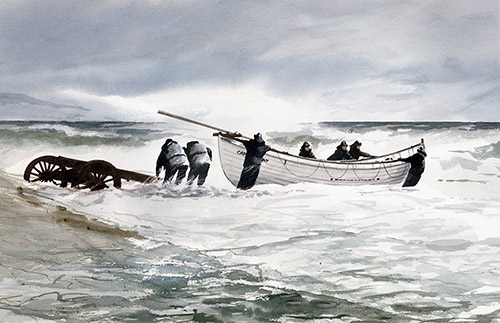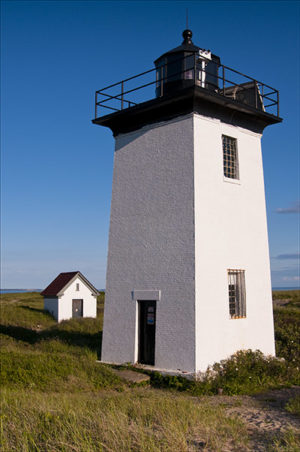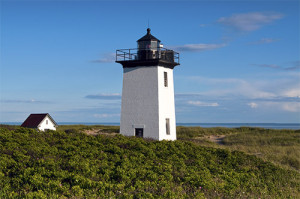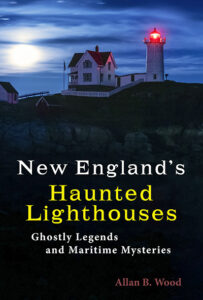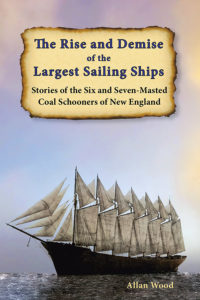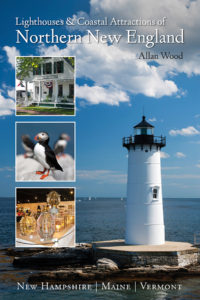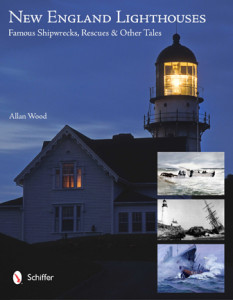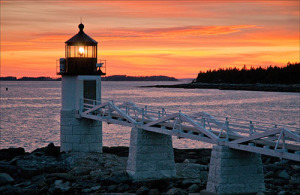Thanksgiving Rescue Near Cape Cod’s Wood End Light
During New England’s Worst Storm
One of the worst storms in New England’s history occurred during the Thanksgiving week of 1898, when two storm systems, one from the Great Lakes and the other from the South, would come together over the New England coast. The collision created a “perfect storm” of blinding snow, sleet, and hurricane-force winds gusting to over 100 miles and leaving destruction all along the New England coastline. The storm lasted over 30 hours, buried New England in 2 feet of snow, and was responsible for the deaths of 400 people.
Provincetown Harbor, one of the safest locations on the coast, could not hold back the storm’s ferocity. The storm destroyed at least ten large ships, schooners, local wharves, and buildings around Provincetown Harbor.
At Wood End Lighthouse, located just outside Provincetown Harbor, Keeper Issac G. Fisher had climbed into the lookout tower just before daybreak and saw the morning patrolman from the lifesaving station nearby, Frank C. Wagner, running back towards the lighthouse. Lifesaving stations were built near lighthouses with trained surfmen who would go out into the waters during fierce storms to rescue survivors of shipwrecks. Wagner had seen two schooners wrecked offshore a couple of miles down and informed Keeper Fisher of the local lifesaving station to sound the alarm. The keeper had his surfmen attempt to bring the lifeboat on the wagon down to the shore, but the fierce winds were so strong that they nearly blew the heavy craft out of the wagon. The men finally had to take the boat off the wagon and drag it into the raging surf, where they were forced to push and pull the vessel in knee-deep freezing waters along the shore for nearly a mile and a half. This task took a couple of grueling, exhausting hours before they finally were within sight of the two schooners that had wrecked during the storm.
The gale was now at its worst intensity as the tired and frozen surfmen tried maneuvering the boat into the surf. Each time they would try to launch the boat, the strength of the winds would force the craft towards the shore. Determined to try to save anyone from either schooner, they relentlessly pushed the boat another mile along the coast to try to gain a better angle against the relenting winds. Hours passed as they continued their daunting task of moving the cumbersome craft along the surf. At 4 p.m., hours after the wrecks were initially sighted, they made another attempt to force the boat into the raging waves, even with the help of four fishermen whom they had enlisted along the way, and still the gale force winds kept blowing against the frustrated crew towards the shore. Again, the crew tried to move the boat along the beach for a better position, and again, they tried to launch the craft against the winds. This time, with all their might, they started slowly to make their way towards the closest of the schooners, the Jorden L. Mott. There, they found five crew members frozen, but four still alive, clinging to the rigging. The fifth member, the captain’s father, had already frozen to death.
The men of the Jorden L. Mott were carefully taken off the rigging and carried onto the lifeboat, still struggling in the raging waves. As darkness approached, the surfmen decided they needed to bring those still alive back to the station before wasting any additional time carrying the captain’s corpse. With the four survivors in the boat, the lifesavers headed for shore with the wind against their backs. When they brought their boat onto the beach, although the station was a short distance from where they landed, it took nearly an hour to get the exhausted, freezing survivors to the station. Two men from the ship, Captain Charles Dyer and one of his crew, were too weak to walk with assistance and had to be carried to the station by the exhausted surfmen. The Wood End lifesavers had been enduring the storm’s hurricane-force winds, sleet, and snow to rescue the survivors for nearly 15 hours. They were exhausted and beginning to display the effects of prolonged exposure to the storm.
It was now nightfall, and any efforts to rescue anyone from the other schooner wreck, the Lester A Lewis, would have been fatal for the rescuers as the storm continued in its intensity. It was believed that all aboard had already perished. The survivors and their rescuers were placed in dry clothing and provided spirits and food for the night. Captain Dyer of the Mott could not walk alone until the following night. The rescued crew stayed at the station for three days until they had recovered enough to travel back to their homes with their expenses paid for.
After the storm had subsided a couple of days later, the Wood End surfmen went out to the wrecks to remove the body of Captain Dyer’s father on the Jorden L. Mott and the five bodies of the crewmen who perished on the Lester A. Lewis. They brought them to Provincetown, where they were adequately taken care of. The efforts of the Wood End lifesavers were regarded as the most heroic under such extreme conditions and were highly praised by the locals and government officials alike. All of the brave rescuers recovered from their ordeal without any long-term effects.
The name of this storm was changed to the “Portland Gale” after the steamship Portland sank with all its passengers and crew during this terrible storm. The storm is a reminder of the many relentless storms that frequent our coast and for all those in service and local individuals who have risked their lives in the past and in our present day, under often challenging conditions, to assist those in peril because it is part of our human nature, to help those in need. Thank you.
Have a safe and joyful holiday season,
Here are a few of my favorite photos of Wood End Lighthouse.
Allan Wood
A Word About Sherman A. Groenke, Master Artist:
The image above, “Launching a Surfboat,” is a painting by world-famous watercolor artist Sherman Groenke, who also served with the United States Coast Guard. His paintings focus on local rural and urban landscapes and landmarks. Groenke, a World War 2 veteran, enlisted in the Coast Guard in 1941 and was assigned to the graphic unit in New York, creating recruiting posters, training charts, and port security signs and posters. In August of 1944, he served in the Pacific Theatre of Operations as a combat artist, painting and sketching on location. After serving in the Coast Guard, Groenke was employed in advertising art studios and agencies in Milwaukee and Chicago until he retired in 1981. Groenke had participated in numerous group and solo shows, including annual representation in Watercolor, Wisconsin. He was an award-winning painter, and his works are represented in many private and corporate collections, including the US Coast Guard.
Books to Explore
New England’s Haunted Lighthouses:
Ghostly Legends and Maritime Mysteries
Discover the mysteries of New England’s haunted lighthouses! Uncover ghostly tales of lingering keepers, victims of misfortune or local shipwrecks, lost souls, ghost ships, and more. Many of these accounts begin with actual historical events that later lead to unexplained incidents.
Immerse yourself in the tales associated with these iconic beacons!
The Rise and Demise of the Largest Sailing Ships: Stories of the Six and Seven-Masted Coal Schooners of New England. In the early 1900s, New England shipbuilders constructed the world’s largest sailing ships amid social and political reforms. These giants were the ten original six-masted coal schooners and one colossal seven-masted vessel, built to carry massive quantities of coal and building supplies and measured longer than a football field! This self-published book, balanced with plenty of color and vintage images, showcases the historical accounts that followed these mighty ships.
Available also from bookstores in paperback, hardcover, and as an eBook for all devices.

Book – Lighthouses and Coastal Attractions in Southern New England: Connecticut, Rhode Island, Massachusetts
Lighthouses and Coastal Attractions of Southern New England: Connecticut, Rhode Island, and Massachusetts. This 300-page book provides memorable human interest stories from each of the 92 lighthouses. You can explore plenty of indoor and outdoor coastal attractions, including whale-watching excursions, lighthouse tours, windjammer sailing tours, parks, museums, and even lighthouses where you can stay overnight. You’ll also find plenty of stories of hauntings around lighthouses.
Lighthouses and Coastal Attractions of Northern New England: New Hampshire, Maine, and Vermont. This 300-page book provides memorable human interest stories from each of the 76 lighthouses. It also describes and provides contact info for plenty of indoor and outdoor coastal attractions and tours. These include whale watching, lighthouse tours, unique parks, museums, and lighthouses where you can stay overnight. There are also stories of haunted lighthouses in these regions.
New England Lighthouses: Famous Shipwrecks, Rescues & Other Tales contains over 50 stories, including more details of the lifesavers’ rescue of the Jordan L. Mott at Wood End Lighthouse. This image-rich book also contains vintage images provided by the Coast Guard and various organizations and paintings by six famous Coast Guard artists.
You can purchase this book and the lighthouse tourism books from the publisher Schiffer Books or in many fine bookstores such as Barnes and Noble.
Copyright © Allan Wood Photography; do not reproduce without permission. All rights reserved.
Join, Learn, and Support The American Lighthouse Foundation
